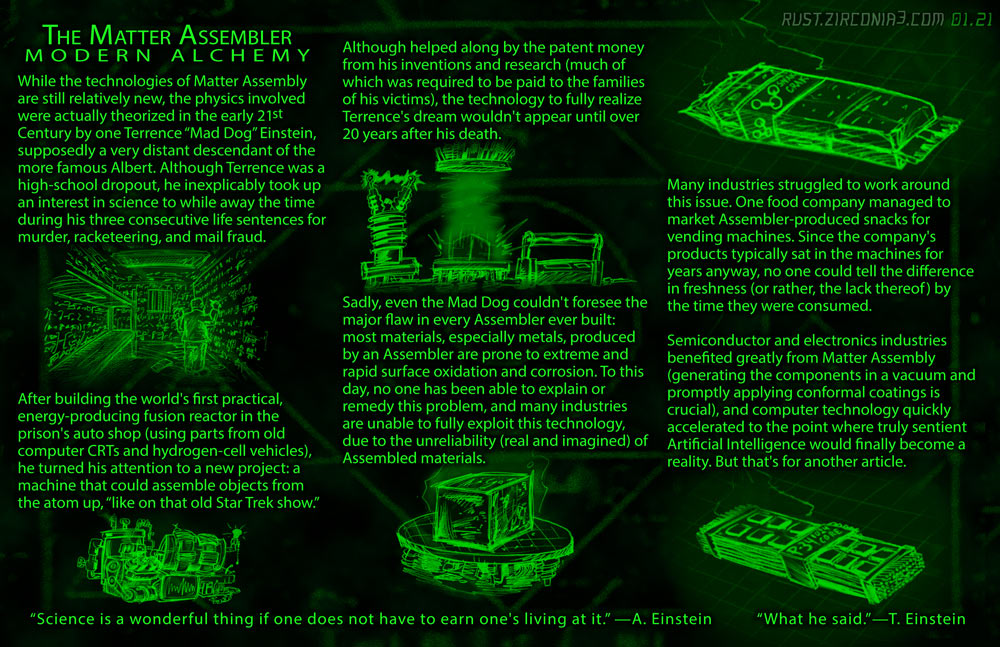I've repeated all that fine print in the notes section, where it's probably easier to read.
There are also author comments below that.
The Matter Assembler
MODERN ALCHEMY
While the technologies of Matter Assembly are still relatively new, the physics involved were actually theorized in the early 21st Century by one Terrence "Mad Dog" Einstein, supposedly a very distant descendant of the more famous Albert. Although Terrence was a high-school dropout, he inexplicably took up an interest in science to while away the time during his three consecutive life sentences for murder, racketeering, and mail fraud.
After building the world's first practical, energy-producing fusion reactor in the prison's auto shop (using parts from old computer CRTs and hydrogen-cell vehicles), he turned his attention to a new project: a machine that could assemble objects from the atom up, "like on that old Star Trek show."
Although helped along by the patent money from his inventions and research (much of which was required to be paid to the families of his victims), the technology to fully realize Terrence's dream wouldn't appear until over 20 years after his death.
Sadly, even the Mad Dog couldn't foresee the major flaw in every Assembler ever built: most materials, especially metals, produced by an Assembler are prone to extreme and rapid surface oxidation and corrosion. To this day, no one has been able to explain or remedy this problem, and many industries are unable to fully exploit this technology, due to the unreliability (real and imagined) of Assembled materials.
Some industries managed to work around this flaw. One food company managed to market Assembler-produced snacks for vending machines. Since the company's products typically sat in the machines for years anyway, no one could tell the difference in freshness (or rather, the lack thereof) by the time they were consumed.
Eventually, electronics and semiconductors benefited greatly from Matter Assembly (once the engineers learned to Assemble their parts in a vacuum and then promptly treat them with a protective coating), and computer technology quickly accelerated to the point where truly sentient Artificial Intelligence would finally become a reality. But that's for another article.
"Science is a wonderful thing if one does not have to earn one's living at it." --A. Einstein
"What he said." --T. Einstein
Author's Notes
Basically, the whole point of that was to try to explain why the Assembler, which seemingly lets you create nearly any object out of thin air without the need for workers or factories, didn't completely devastate the economy-- many of the materials it produces are suspect. It also gives our hero a nice Achilles Heel-- his kryptonite is, well, oxygen. I've had the idea of "a robot that could transform into anything" since high school, but the inspiration for this current character and his particular vulnerability was based on me imagining my vehicle at the time-- a 20-year-old Ford Courier (a dinky little 4-cylinder pickup) whose bed was so ate-up you'd put your foot through it if you tried to stand on it-- as a TransFormer. And then there is that episode of classic TransFormers titled "Cosmic Rust" in which the title characters are nearly consumed by metal-eating space germs.
As for the Einstein scenario described above, I really wasn't sure about it at first. It's just stupid and random, and not entirely original-- I half-remembered a bit from the first Red Dwarf novel, where Albert Einstein had started to work out a principle for time stasis fields, but got distracted by an affair with Marilyn Monroe, but his notes were eventually discovered and brought to fruition. I merely made up something like that, but even weirder. I wasn't happy with it, but it was better than nothing, and I went ahead with it. Later that day, I got lost on a website of famous quotations, and checked out Einstein's page, and found that quote. Perfect. A quick edit, And All Was Right With The World.

